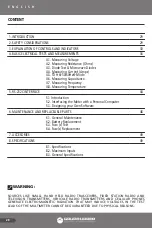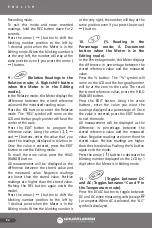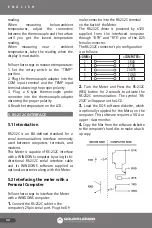
E N G L I S H
40
CAUTION: THE CURRENT FUNCTIONS ARE
PROTECTED BY A FUSE OF 600 VOLT RATING.
TO AVOID DAMAGE TO THE INSTRUMENT,
CURRENT SOURCES HAVING OPEN CIRCUIT
VOLTAGES GREATER THAN 600 VOLTS DC
OR AC MUST NOT BE MEASURED.
NOTE: When taking current measurements,
this Meter must be connected in SERIES with
the circuit (or circuit element) under test.
NEVER CONNECT THE TEST LEADS ACROSS
A VOLTAGE SOURCE while the rotary switch
is set to Amps. This can cause damage to the
circuit under test or this Meter.
• To measure current, you must break the
circuit and connect the tests leads to two
circuit connection points. The connection
must be in series with the current.
• AC current measuring circuit in this Meter
is of root-mean-square (True-RMS) value
system so this Meter can accurately
measure AC current of non-sinusoidal
wave forms including harmonics caused
by various non-linear loads. The AC crest
factor of this Meter is 3 for the frequency
range of 45Hz to 1KHz.
• When measuring current, the Meter’s
internal shunt resistors develop a voltage
across the Meter’s terminals called
“burden voltage”. This voltage drop may
affect precision circuits or measurements.
Follow these steps to measure DC (or AC)
Amps:
1. Set the function and range switch to the
desired DC A (or AC A) range. If you do
not know the value of the current to be
measured, always start with the highest
range and reduce the setting as required to
obtain a satisfactory reading.
2. Plug the red test lead into the “mAμA”
input terminal (if the 4A or 10A ranges
are being used, plug the red test lead into
the “A” input terminal) and the black test
lead into the “COM” input terminal of the
instrument.
3. Disconnect the power from the circuit to
be tested.
4. Connect the test leads in series to the
circuit to be tested.
5. Reapply power to the circuit, the
measured current will appear on the display
of the instrument.
6. Disconnect power to the circuit before
removing the test leads from the circuit.
4.5 TDH @ 50/60Hz® Mode
Today, more and more electrical appliances
are using high efficiency power supplies
and adjustable speed motors to conserve
energy. These appliances conserve
power by drawing current in short
pulses using a solid state switch. This
trend, although saving energy, creates
severe problems in power distribution.
These solid state create non-linear loads
on the power distribution systems, which
generate harmonics.
This harmonics are odd multiples of the
fundamental power line frequency, and
may cause overheating in transformers,
erratic computer operation and premature













































